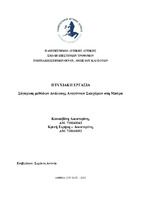| dc.contributor.advisor | Σεχάντε, Αντνάν | |
| dc.contributor.author | Κουκοβίνη, Αικατερίνη | |
| dc.contributor.author | Κριτή, Ειρήνη - Αικατερίνη | |
| dc.date.accessioned | 2022-08-28T08:02:10Z | |
| dc.date.available | 2022-08-28T08:02:10Z | |
| dc.date.issued | 2022-07-22 | |
| dc.identifier.uri | https://polynoe.lib.uniwa.gr/xmlui/handle/11400/2800 | |
| dc.identifier.uri | http://dx.doi.org/10.26265/polynoe-2640 | |
| dc.description.abstract | Η μπύρα είναι ένα αλκοολούχο ποτό, γνωστό από την αρχαιότητα. Έχει ως πρώτες ύλες το νερό που αποτελεί το 90%, το κριθάρι ως αμυλούχο υπόστρωμα το οποίο μετά την υδρόλυσή του θα δώσει τα σάκχαρα, το λυκίσκο, ο οποίος προσδίδει γεύση και άρωμα και τις ζύμες που είναι απαραίτητες στην αλκοολική ζύμωση. Στην διαδικασία της βυνοποίησης, η βύνη απελευθερώνει φυσικά ένζυμα που χρησιμοποιούνται για να μετατρέψουν το άμυλο σε σάκχαρα. Τα σάκχαρα αυτά, κατά τη ζύμωση, καταναλώνονται και μεταβολίζονται από τις ζύμες σε αλκοόλη και διοξείδιο του άνθρακα. Συγκεκριμένα, στο γλεύκος μπύρας υπάρχει μαλτόζη σε ποσοστό 50% των υδατανθράκων του γλεύκους, μαλτοτριόζη 18%, γλυκόζη 10%, σακχαρόζη 8% και φρουκτόζη 2%, ενώ υπάρχουν και δεξτρίνες που καταλαμβάνουν το 12% των εναπομείναντων υδατανθράκων.
Στην παρούσα πτυχιακή εργασία, θα παρουσιαστεί ο προσδιορισμός των αναγόντων σακχάρων που υπάρχουν στην μπύρα με δύο μεθόδους καθώς και η σύγκριση των μεθόδων αυτών. Ειδικότερα, προσδιορίστηκαν τα ανάγοντα σάκχαρα γλυκόζη, φρουκτόζη και μαλτόζη και το μη ανάγον σάκχαρο σακχαρόζη με τη μέθοδο Luff και Lane – Eynon. Οι δύο αυτές μέθοδοι βασίζονται στην ιδιότητα των αναγόντων σακχάρων να οξειδώνονται κατά την αντίδραση με διάλυμα θειικού χαλκού.
Η μέθοδος Luff φάνηκε ότι λειτουργεί για τον προσδιορισμό της γλυκόζης, της φρουκτόζης και της σακχαρόζης, ενώ για την μαλτόζη οι τιμές δεν ήταν αναμενόμενες. Ομοίως, η μέθοδος Lane – Eynon φάνηκε ότι λειτουργεί για τα ίδια σάκχαρα, ενώ για τη μαλτόζη τα αποτελέσματα δεν ήταν ικανοποιητικά.
Συγκρίνοντας και τις δύο μεθόδους, συμπεραίνεται ότι η μέθοδος Luff και Lane – Eynon δεν μπορούν να χρησιμοποιηθούν για να προσδιορίσουν τα ανάγοντα σάκχαρα στη μπύρα καθώς όπως αποδείχθηκε δεν λειτουργούν σε υδατικά διαλύματα. | el |
| dc.format.extent | 71 | el |
| dc.language.iso | el | el |
| dc.publisher | Πανεπιστήμιο Δυτικής Αττικής | el |
| dc.rights | Αναφορά Δημιουργού - Μη Εμπορική Χρήση - Παρόμοια Διανομή 4.0 Διεθνές | * |
| dc.rights | Attribution-NonCommercial-NoDerivatives 4.0 Διεθνές | * |
| dc.rights.uri | http://creativecommons.org/licenses/by-nc-nd/4.0/ | * |
| dc.subject | Ανάγοντα σάκχαρα | el |
| dc.subject | Γλυκόζη | el |
| dc.subject | Μαλτόζη | el |
| dc.subject | Μέθοδος Lane – Eynon | el |
| dc.subject | Μέθοδος Luff | el |
| dc.subject | Μπύρα | el |
| dc.subject | Σακχαρόζη | el |
| dc.subject | Φρουκτόζη | el |
| dc.title | Σύγκριση μεθόδων ανάλυσης αναγόντων σακχάρων στη μπύρα | el |
| dc.title.alternative | Comparison of reducing sugar analysis methods in beer | el |
| dc.type | Πτυχιακή εργασία | el |
| dc.contributor.committee | Ευαγγέλου, Αλεξάνδρα | |
| dc.contributor.committee | Tataridis, Panagiotis | |
| dc.contributor.faculty | Σχολή Επιστημών Τροφίμων | el |
| dc.contributor.department | Τμήμα Επιστημών Οίνου, Αμπέλου και Ποτών | el |
| dc.description.abstracttranslated | Beer is an alcoholic beverage, known since ancient times. Its raw materials are water, 90% of beer, barley, as a starchy substrate that releases sugars from its hydrolysis, hops, which imparts flavor and aroma, and the yeasts necessary for alcoholic fermentation. In the malting process, the malt releases natural enzymes that are used to convert starch into sugars. These sugars are consumed and metabolized by the yeasts into alcohol and carbon dioxide during fermentation. Specifically, the percentage of the carbohydrates in beer wort is 50% maltose, 18% maltotriose, 10% glucose, 8% sucrose and 2% fructose, while there are also dextrins that occupy 12% of the remaining carbohydrates.
This thesis presents and compares two methods used for the determination of the reducing sugars in beer. Specifically, Luff and Lane – Eynon methods were utilized for measuring the reducing sugars glucose, fructose and maltose and the non-reducing sugar sucrose. Both of these methods are based on the ability of the reducing sugars to be oxidized in the presence of copper sulfate.
From the utilized methods, both the Luff and the Lane–Eynon methods appeared to be effective for the quantification of glucose, fructose and sucrose but not of maltose. Specifically, the results from measuring maltose via the Lane–Eynon method were unsatisfactory. However, the comparison of the methods showed that both Luff and Lane–Eynon methods cannot be used in beer as they do not work efficienlty in aqueous solutions. | el |


